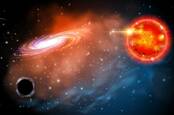This article is more than 1 year old
You cannae break the laws of physics, cap'n... Boffins call BS on 'impossible' black hole, fear readings were botched
We knew it was too good to be true
Updated An impossibly massive black hole that defied conventional theories has been called into question after multiple researchers suggested the data used to estimate the object’s mass may have been wrong.
The stellar black hole was first reported to be 70 times as massive as the Sun, according to a Nature paper last month. Stellar black holes formed from the death of stars are smaller than the supermassive black holes found at the center of active galaxies. Theoretical models predict that the voids leftover from stellar black holes should have a limited mass of up to ten solar masses.
In other words, the mass of black holes should fall within specific ranges. They can either be small, between three to ten solar masses, or intermediate-sized, between 100 to 100,000 solar masses, or supermassive at 100,000 to a billion solar masses. So when a study describing one that doesn’t fit in any of the categories was published in a top peer-reviewed publication, the research community was intrigued.
The original paper, written by a large international team of physicists led by the University of the Chinese Academy of Sciences, describes an odd binary system known as LB-1. Located at least 7,000 light years away, the system is made up of a heavy B-type star and an oversized black hole.
The researchers estimated the black hole’s mass by measuring the effect that the two objects in the system have on each other. Since the star is much smaller in comparison to the hole, its orbital motion is affected by its larger companion. The black hole also wobbles slightly as it gravitationally interacts with the star. The mass of the black hole can then be crudely estimated by conservation of momentum.
But two separate papers submitted this week by two different teams, however, suggest that the data used for these calculations is incorrect.
The original paper measures the black hole’s wobble by observing the shift in its so-called H-alpha emission line in the black hole's accretion disk. But the H-alpha emission line doesn’t actually come from the black hole at all, so the calculations of its mass are incorrect, they stated.
“We showed that the velocity of the H-alpha emission line is not changing with time - it's constant,” Kareem El-Badry, an astronomy PhD student at the University of Berkeley, California, told The Register. “If it were coming from the black hole, the velocity would change a bit as the black hole goes around its orbit.”
The problem was that the original researchers failed to consider the effects of stellar absorption. “They didn't account for the fact that the H-alpha absorption line - coming from the star - is Doppler shifting back and forth underneath the emission. This made it seem like the H-alpha emission line was Doppler shifting back and forth, even though it wasn't,” he said.

Astroboffins rethink black hole theory after spotting tiny example with its own star buddy
READ MOREAbsorption lines describe the light absorbed by a star, and the emission lines describe the light emitted. The two are inextricably linked, since the atoms in the star will absorb and emit electromagnetic energy at the same frequency.
“As the absorption line shifts back and forth, it makes it look like the emission line is also shifting back and forth, even though it isn't,” El-Badry explained. The original measurement of the H-alpha emission line believed to be emanating from the black hole is, in fact, from a larger circumbinary disk of material that encircles both the black hole and the star.
"The observed spectrum contains both absorption lines which come from the star and an emission line H-alpha. The original paper thought the H-alpha emission line came from an accretion disk around a black hole. We instead think it comes from a larger accretion disk around both the black hole and the star or from other material that is orbiting the center of mass of the binary, not the star or the black hole," he said.
“I don't think the paper is correct, but since several groups have now rebutted them, the scientific community will decide whether or not to believe the claims, regardless of whether or not the paper is not retracted.”
The Register has asked the lead authors of the original paper for comment. ®
Updated to add
Jifeng Liu, first author of the original study published in Nature and a professor in the School of Astronomy and Space Sciences at the University of Chinese Academic Sciences. still believes the H-alpha emission lines are from the brobdingnagian black hole.
"The main thing we argue for a high black hole mass and a small inclination angle is the H-alpha emission line width and shape, plus a small motion of the line," he told El Reg.
The rebuttals claim that the wobble in the H-alpha emission lines disappear when stellar absorption is taken into account. Whilst Liu agreed that the H-alpha lines shifted less after considering stellar absorption, they still exhibit a slight motion from the effects of the black hole. "While it is not moving as much with the black hole after the H-alpha absorption line subtraction, it is still moving," he insisted.
Liu also said that his team had managed to obtain readings of a different type of emission line that supports the idea that the black hole really is 70 solar masses.
"We have new infrared observations of Paschen emission lines, and it is really difficult to imagine how one can get the H-alpha and Paschen line width and shape for an edge-on system. So we are composing a new paper, aimed to appear in arXiv early next week."
So the battle of the astroboffins continues.
